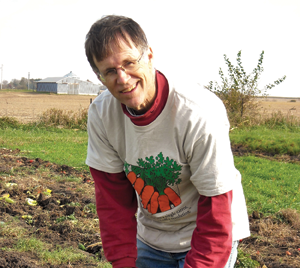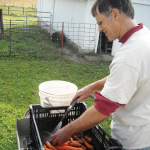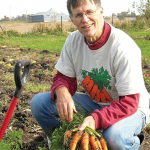- Washing
- Organic Carrots
- Guthrie
Delivering Flavor, Freshness are Crowning Achievements for Iowa’s Carrot King
By Eric Woolson
In a state where nation-leading corn and soybean harvests are the undisputed rulers of production agriculture, Iowa organic grower Gary Guthrie proudly wears the crown of The Carrot King. The moniker was bestowed upon him years ago by a writer who was wowed by the taste of a crispy, sweet Bolero. Even though Guthrie’s empire never exceeded several acres and has been wound down over the past few years, he will continue to exert a positive influence on the community-supported agriculture movement that continues to grow in the Hawkeye State.
“When it comes to carrots, he is as passionate as they come,” says Kevin Rettig, owner and general manager of The Café, an Ames eatery that marked its 13th year in business in January. “He was one of the first people on board when we opened to supply us with local products, which was a big part of what we were doing from the start. The quality of his product is always outstanding as is the quality of the conversation every time he comes here. He’s a genuinely good person.”
Recalling an early encounter with Rettig, Guthrie says, “Kevin told me, ‘I love your carrots because there’s no wastage. We get carrots from California and within a week, they’re not doing so well. Yours are a lot fresher and they keep indefinitely.’ I knew then that we were on to something.”
Finding His Calling
Guthrie, who graduated with an agronomy degree from Iowa State University where his father was an entomologist, covered a lot of territory before ending up back on the family farmstead in 1997.
“My dad wanted me to get my Ph.D. It’s that whole father-son thing,” he smiles. “I didn’t, but I was the only one to follow him into agriculture. It took a while to sort out what I really wanted to do, but I decided I wanted to work overseas and I just really wanted to help people.”
After working for a private seed company in the early 1980s, Guthrie answered the calling to work with the Mennonite Central Committee in Bolivia, where he helped create sustainable farming systems in the semi-tropical rainforest while attempting to reduce deforestation.
“I was a pioneer living in a mud house with a tin roof. I loved the ruggedness of it all,” he recalls.
Guthrie met his future wife, Nancy Tielkemeier, there and they married in 1986. They spent three years administering a corn and bean fertilizer program and working with farmers to improve their sustainable farming practices in El Salvador during its bloody civil war.
“The cost of getting their product to market was so high, the farmer doesn’t get very much for it,” he laments. “You go down there thinking you’re going to help people grow more of whatever, and you get a lesson in international economics and climate warming and you find things are more complex than you thought.”
Upon returning from El Salvador, the Guthries worked for the Iowa Peace Network, but, “working for a peace organization for six years is about twice the usual length. There’s a high burnout rate. We were thinking, ‘This is not what we want to do for rest of our lives. What are we going to do next?’”
He attended a 1996 workshop about community-supported agriculture (CSA) and came away thinking he’d found what he was looking for “because it really allowed me to incorporate everything I did in my life – community development, agricultural development and spirituality – all in one.”
He spoke to his parents about their plans for the family farm’s future and his interest to work the land but he didn’t mention his newfound CSA plans on part of the land.
“We realized if that was not an option it was okay, but,” he adds with a laugh, “I did make a veiled threat that we might have to go back overseas.”
Growing the Farm
As he waited to move onto the farm, Guthrie started with a small garden and delivered vegetables himself the second half of the growing season.
He connected with the Practical Farmers of Iowa and the now-defunct Iowa Network for Community Agriculture and credits them with providing the knowledge base and support network that helped Growing Harmony Farm flourish. Being on the edge of a city with a land grant university known for its agriculture research and teaching was a boon to Guthrie, and he frequently tapped the resources of Iowa State University’s Leopold Center for Sustainable Agriculture.
Starting with just two customers, he grew his client list to 75 families, the Wheatsfield Co-Op and three restaurants within a 10-mile radius of his farm by the time he decided to retire. When Guthrie was farming fulltime, his peak output was 33 beds of carrots that normally produced between 4,000 and 5,500 pounds of carrots. His peak year topped 7,500 pounds, and his 2015 production included roughly 2,500 pounds, with half in summer carrots and the rest in his fall Bolero crop.
Guthrie says he simply got lucky when he selected the Bolero, a high-yielding, deep-orange Nantes variety that grows well in heavy soil, like that in Iowa, and remains sweet even in storage.
Someone had recommended he consider buying from Johnny’s Select Seed. The company’s catalog touted the Nelson as one of the best summer carrots and hailed the Bolero’s storability and delicious flavor.
“So I started with them,” Guthrie recalls. “Lo and behold, Organic Gardening a year or two later had a taste testing of all the varieties and the Bolero was the top one. Then my neighbors started saying, ‘Those are the best carrots I’ve ever tasted.’ So many kids have tasted them and then gone back to their parents and said, ‘Can I have another?’ I just laugh because when do you ever hear that?”
Cultivating Carrots in Iowa
Guthrie has encountered growing challenges through the years. In wet years, the Nelsons were susceptible to Alternaira leaf blight. The Bolero, with its vigorous top growth, generally didn’t experience such problems. Still, both varieties “required a lot of effort and that’s another reason my niche grew; no one else was willing to do it,” Guthrie says.
He notes the commercial industry has spent considerable time and money trying to develop a variety with the inviting flavor of a Nelson that can be machine-harvested.
“So far, they can’t do it because (Nelsons) are basically coreless,” he says. “That’s the advantage of small growers who do things by hand.”
Guthrie touts Iowa’s northern climate as another plus, as it turns carrots’ starch into sugar after the first hard frost, typically by mid-October.
The soil on his central Iowa farm is a Clarion/Nicollet loam built up over the years with organic matter, including sunn hemp, a nitrogen-rich Asian legume often grown for green manure. Guthrie attributes that high organic matter with helping to “moderate some of the extremes” so that his crops did well even during unusual dry seasons. The use of cover crops in the winter has “made a huge difference for weed control.”
“You’re always going to have weeds, but my weed management is pretty minimal now,” Guthrie says. “I’m convinced it makes a big difference in suppressing disease, too.”
While he retired his CSA in 2010 and has scaled back his commercial operation in the years since, Guthrie still provides organic carrots to Rettig’s business and several other local restaurants.
As Guthrie began winding down the CSA, he came to realize “just how many lives you touch by allowing this to happen because of the multiplying effect of all these people buying and selling vegetables and fruit.”
He adds, “I had no way of knowing that when we first started. I have a quote by Paul Cezanne on my t-shirt which says, ‘The day is coming when a single carrot, freshly observed, will set off a revolution.’ Certainly that day has arrived!”





